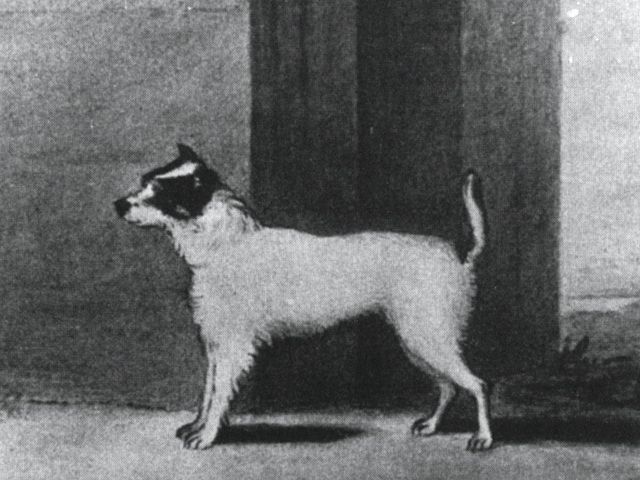The Jack Russell Terrier Club
Established 2016
History of the Jack Russell Terrier
John Russell, born in 1795, in Devon became interested in animals and hunting from a young age. He went on to become a churchman and enthusiastic hunter which gained him the nickname of “the Sporting Parson.”
Whilst at Oxford University Russell discovered “Trump” who he spotted hitching a ride on the back of a milk wagon. This bitch was to become the mother of the Jack Russell Terrier breed after Russell struck a deal to buy her. Trump was mostly white which Russell preferred as spotting a white dog whilst hunting is much easier than spotting a dog which has only brown/black markings.
The breeding of the predominately white Trump with a black and tan terrier led to the familiar characteristics for the breed we know so well today.
Trump
Jack Russells being bred to hunt foxes had to work alongside hounds and cover extensive distances without slowing whilst being small enough to enter a fox den and be bold and brave enough to uphold the fox. These traits say a great deal for their unwavering tenacity, strong mindedness and ability to get along well with other dogs not to mention digging like their lives depend on it!
Following John Russell’s death two southern men made serious progress to continue the standard, both having dogs descended from one of John Russell’s dogs. They aimed for a dog not as large as the show fox terrier and ideally weighing below 15 pounds.
The first breed standard was created by Arthur Blake Heinemann and in 1894 the Devon and Somerset Badger Club was founded whose aims were to promote badger digging rather than fox hunting and so breeding of terriers to fit this purpose.
Terriers were acquired from Nicholas Snow of Oare and were likely descendants of John Russell’s original dogs as Russell would have hunted at some point with Snow’s hunting club and so probably provided some of their original terriers. At the onset of the 20th century Russell’s name became associated with this breed of dog.
The club later changed it’s name to the Parson Jack Russell Terrier Club. Badger digging proved to require a different type of dog than fox hunting therefore likely that Bull terrier stock was bought in to enforce the breed which may have formed the a shorter legged type of Jack Russell. Whilst a divide was becoming apparent between the show and working fox terriers a further split was happening between two different types of white terrier both carrying Jack Russell’s name.
Heinemann was asked to judge classes for working terriers at Crufts with a sight to bring working terriers back into the show ring to try and influence those that disregard working qualities in dogs. The classes continued for several years by various judges but Charles Cruft dropped the attempt because the classes were never largely competed. After Heinemann’s death in 1930 the leadership of the club passed to Annie Harris however the club itself diminished just before World War II.
Post World War II the need for hunting dogs declined as did the numbers of Jack Russell terriers. The dogs were found more in the domestic home as family and companion dogs. More cross breeding occurred with Welsh Corgis, Chihuahuas and other small terrier breeds. The offspring of these crosses became known as “Russell Terriers”, “Puddin’ Dogs” or “Shortie Jacks”.
Modern Day History of the Jack Russell Terrier
The Jack Russell Terrier was never originally incorporated into the Kennel Club in the U.K.
In 1990 a standard was written in the U.K for a taller Jack Russell Terrier (12-15 inches) and given the name Parson Jack Russell Terrier which in turn, ten years later, became the Parson Russell Terrier. At the same time the U.S.A. followed suit and adopted the Parson Russell Terrier into the American Kennel Club.
Separate to what was happening in the U.K and the U.S.A.enthusiasts in Australia were also working to develop the breed.
Dedicated breeders in Australia endeavoured through line-breeding, to bring the height down to 12 inches and under, since migrants from the U.K had introduced Parson Terrier’s Ancestry with heights up to 15 inches to them.
A standard was set to this “new” kennel club breed in Australia as a Jack Russell Terrier, and the breed was permitted to be shown at Australian National Kennel Council (ANKC) shows. Jack Russells took the terrier ring by storm and it was not long before they were winning Group and Best in Show awards.
The Federation Cynlogique International recognised the Jack Russell Terrier as a breed in 2001 with the Australian Standard.
Since FCI recognition, the Jack Russell Terrier has become one of the most popular breeds in the terrier group all over Europe.
Although everyone acknowledges that the country of origin of The Jack Russell Terrier is the U.K, Australia must be given credit for making this terrier into a Kennel Club breed, with a written standard.
Show people in the U.K started to notice these little terriers being shown outside the U.K and became smitten with their happy disposition and appealing look. A group of enthusiasts lead by Geoff Corish started to campaign for the Jack Russell Terrier to finally be a recognised breed by the Kennel Club in the UK. A few years down the line, after much paper work and meetings Geoff Corish later received the desired phone call from the Kennel Club to confirm that the Jack Russell Terrier would be officially recognised as a breed from 1st January 2016.
The Jack Russell Terrier & The Kennel Club - 2015 Announcement


